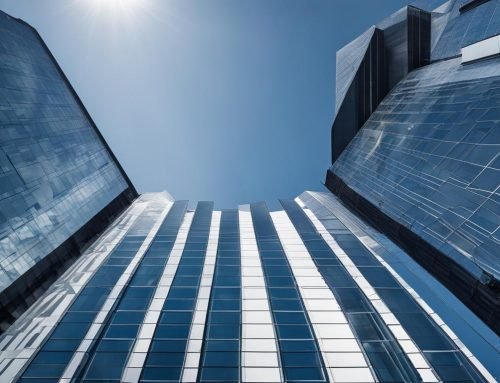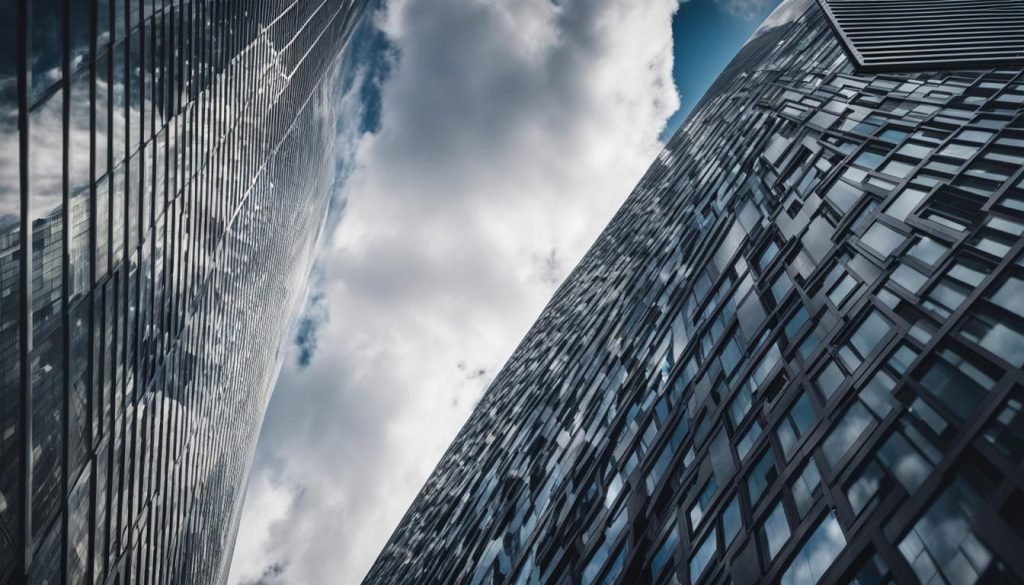
Architectural photography editing is a crucial step in enhancing the visual appeal of architectural images. To achieve stunning and professional results, photographers often rely on professional editing services. In this complete guide, we will explore the various techniques and tools used for architectural photo retouching. Whether you are an aspiring architectural photographer or a seasoned professional, this guide will help you elevate your images to a new level.
When it comes to architectural photography, capturing the beauty and uniqueness of architectural subjects is essential. However, the process doesn’t end with the click of the shutter. The art of architectural photography editing allows photographers to take their images to the next level, bringing out the best in their captures.
Professional editing services are often sought after by architectural photographers to ensure their photographs are enhanced and perfected. These services provide photographers with the expertise and tools necessary to transform their images into stunning works of art. Whether it’s adjusting exposure and white balance or removing distractions and correcting lens distortion, professional editing services can make a significant difference in the final outcome.
Architectural photography editing is not limited to professionals alone. Even if you’re an amateur photographer or an architect looking to showcase your work, learning the techniques and tools of architectural photo retouching can greatly enhance the visual impact of your images.
In this comprehensive guide, we will delve into the key editing techniques, essential tools, and workflow for architectural photography editing. We will also discuss some common challenges faced during the editing process and provide valuable tips for achieving outstanding results. By the end of this guide, you will be equipped with the knowledge and skills to create high-quality architectural photography that captivates viewers and showcases your unique vision.
Key Takeaways:
- Architectural photography editing is essential for enhancing the visual appeal of architectural images.
- Professional editing services can greatly improve the quality of architectural photographs.
- Key editing techniques include adjusting exposure, enhancing colors, and correcting lens distortion.
- Essential tools for architectural photography editing include Adobe Lightroom and Adobe Photoshop.
- A systematic workflow is crucial for efficient and consistent editing.
Understanding Architectural Photography Editing
Before delving into the editing process, it is crucial to grasp the goals and techniques behind architectural photography editing. The primary objective is to enhance the visual appeal of the images while maintaining a realistic representation of the architectural subjects. This involves various techniques, such as architectural photo retouching, where imperfections are corrected, and architectural image enhancement, where the overall aesthetic quality is improved. These techniques are vital for producing high-quality architectural photography that captivates the attention of viewers.
Architectural photo retouching plays a significant role in the editing process. It allows photographers to correct flaws and imperfections present in the original images, such as dust spots, lens flares, or unwanted elements. By meticulously retouching these imperfections, photographers can ensure the final images are visually appealing and free from distractions.
On the other hand, architectural image enhancement focuses on improving the overall visual quality and aesthetics of the photographs. This can involve adjusting exposure and white balance to achieve the desired lighting and color tones. By enhancing colors and contrast, photographers can make architectural details more prominent and create a visually striking image that conveys the true beauty of the subject.
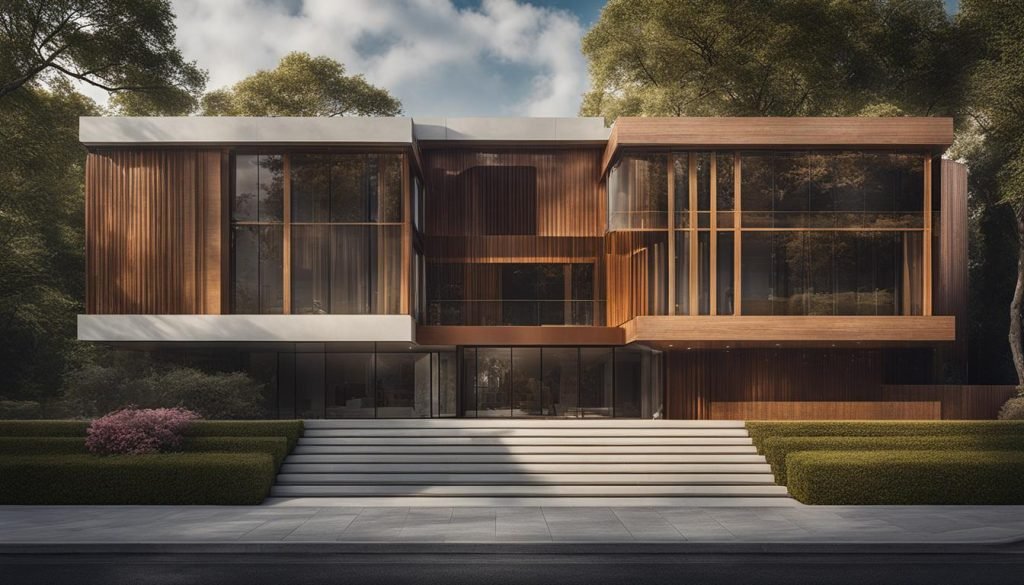
Architectural Photography Editing Techniques:
- Adjusting exposure and white balance
- Enhancing colors and contrast
- Removing distractions
- Straightening vertical lines
- Correcting lens distortion
These techniques, when executed skillfully, can transform ordinary architectural photographs into visually stunning works of art. Understanding the goals and techniques behind architectural photography editing is pivotal for photographers seeking to elevate their images to new heights.
Key Editing Techniques for Architectural Photography
Editing is an essential part of the architectural photography process, allowing you to enhance the visual impact of your images and create stunning results. To achieve this, there are several key editing techniques that you should be familiar with.
Firstly, adjusting exposure and white balance is crucial to ensure that your images are properly exposed and color balanced. This can be done using software like Adobe Lightroom, where you can fine-tune the exposure levels and correct any color casts. By getting the exposure and white balance right, you can enhance the overall aesthetic quality of your architectural photographs.
Another important technique is enhancing colors and contrast. By increasing the saturation and contrast, you can make the colors in your images more vibrant and bring out the details in the architecture. This can help create a visually striking image that captures the viewer’s attention.
Removing distractions is also a key editing technique in architectural photography. Whether it’s stray objects, people, or unwanted reflections, eliminating these distractions can significantly improve the composition and visual impact of your images. This can be done using the clone stamp or healing brush tool in editing software, allowing you to seamlessly remove any unwanted elements from your photographs.
Architectural Photo Post-Processing
Architectural photo post-processing techniques such as dodging and burning, sharpening, and noise reduction can further enhance the quality of your images. Dodging and burning involves selectively brightening or darkening specific areas of an image to create more depth and dimension. Sharpening helps to enhance the details and textures in the architecture, while noise reduction reduces any grain or noise that may be present in the photograph.
By mastering these key editing techniques and utilizing architectural photo post-processing methods, you can take your architectural photography to new heights. These techniques will allow you to create visually stunning images that highlight the unique features and beauty of the architecture, captivating your viewers and leaving a lasting impression.
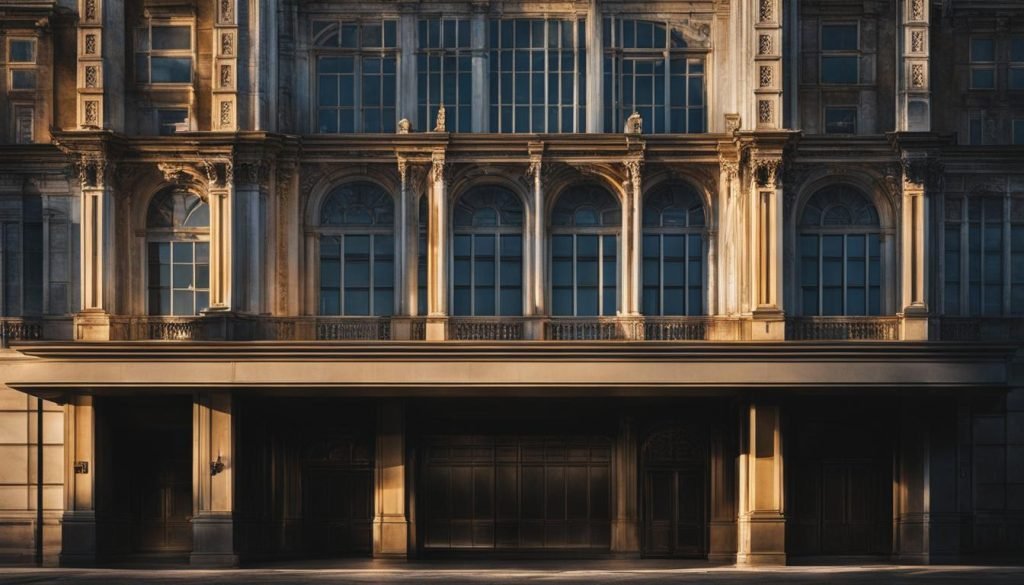
Essential Tools for Architectural Photography Editing
When it comes to editing architectural photographs, having the right tools is essential. Professional editing software such as Adobe Lightroom and Adobe Photoshop offer a wide range of features specifically designed for architectural photography editing. These tools provide precise control over exposure, color manipulation, and various image adjustments, allowing you to bring out the best in your architectural images.
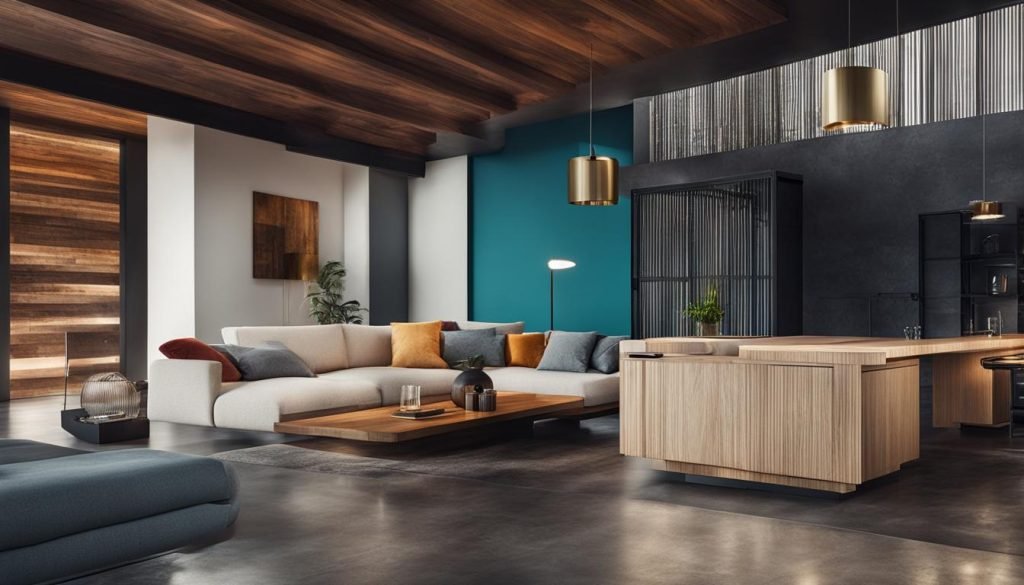
Plugins and presets developed specifically for architectural photography can also streamline the editing process and save you time. These additional tools offer specialized functionalities that can further enhance your images and give them a unique look. Whether you’re looking to correct perspective distortion, enhance details and textures, or create stunning HDR effects, there are plugins and presets available to help you achieve your desired results.
Having the right hardware is also essential for efficient and smooth editing. A powerful computer with sufficient RAM and a high-resolution monitor will provide the necessary processing power and display accuracy for working with large and detailed architectural images. Additionally, a graphics tablet can be a valuable tool for precise adjustments and retouching.
Key Points:
- Professional editing software like Adobe Lightroom and Adobe Photoshop offer precise control over exposure, color manipulation, and image adjustments
- Plugins and presets developed specifically for architectural photography can streamline the editing process and provide specialized functionalities
- A powerful computer with sufficient RAM and a high-resolution monitor ensures efficient and accurate editing
- A graphics tablet can be a valuable tool for precise adjustments and retouching
Workflow for Architectural Photography Editing
Developing a streamlined workflow is essential for efficient architectural photography editing. By organizing and managing the editing process from start to finish, you can ensure consistent and high-quality results in your images. Here’s a step-by-step guide to help you establish your own workflow:
- Import and Cull: Start by importing your architectural photographs into your editing software of choice. Review each image and eliminate any duplicates or shots that don’t meet your desired criteria.
- Basic Adjustments: Begin the editing process by making basic adjustments to the overall exposure, color balance, and tone of the images. This is a crucial step in setting the foundation for further editing.
- Specific Editing Techniques: Apply specific editing techniques to enhance the architectural photography. This may include straightening vertical lines, removing distractions, adjusting white balance, enhancing colors and contrast, and correcting lens distortion.
- Fine-tuning: Spend time fine-tuning the images to ensure they meet your artistic vision. This may involve further adjustments to exposure, contrast, and color, as well as fine-tuning details such as sharpness and noise reduction.
- Exporting: Once you are satisfied with the edits, export the images in the desired format, ensuring they are optimized for the intended use (print, web, etc.).
Remember, this workflow is just a starting point, and you can customize it to fit your specific needs and preferences. By establishing a consistent and efficient workflow, you can streamline your editing process and produce high-quality architectural photographs.
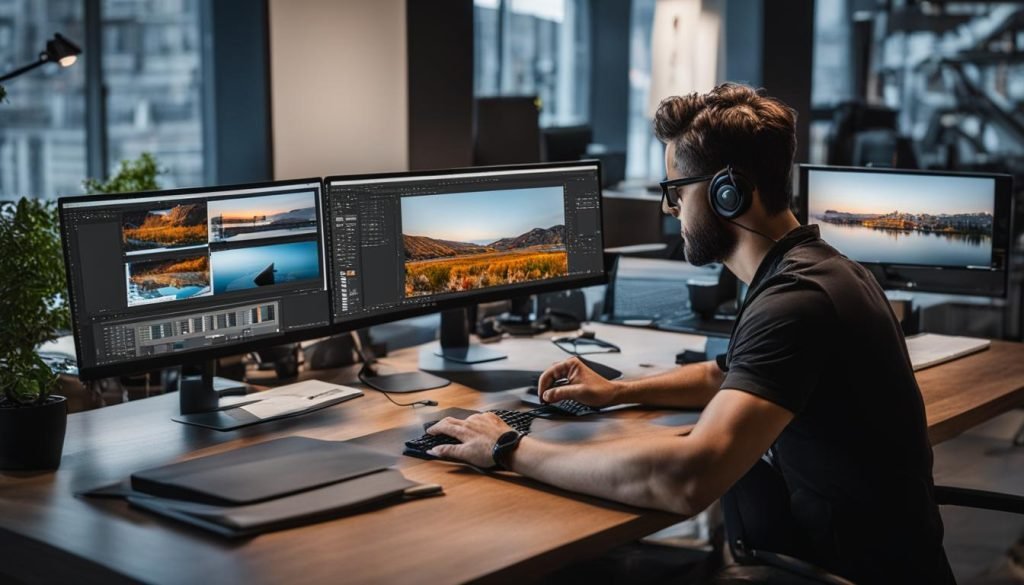
Retouching Tips for Architectural Photography Editing
When it comes to architectural photography editing, there are several useful tips that can help you achieve outstanding results. Paying attention to details is crucial in capturing the essence of the architectural subjects. Whether it’s the intricate design elements or the textures of the materials, highlighting these details can elevate your images to a new level. Use selective editing techniques to enhance specific areas of the photograph, bringing focus to important features.
Maintaining a natural look is essential in architectural photography editing. Avoid over-editing or excessive manipulation that can make the images appear unrealistic. The goal is to enhance the visual appeal while still maintaining a faithful representation of the architectural subjects. Use layer masks for non-destructive editing, allowing you to make adjustments without permanently altering the original image. This gives you flexibility and control over the editing process.
Experimenting with different editing styles can help you discover new creative possibilities. Architectural photography can be portrayed in various ways, depending on the mood and atmosphere you want to convey. Whether it’s a bright and vibrant look or a more moody and dramatic feel, adjusting colors, contrast, and lighting can create a unique visual narrative. Take inspiration from renowned architectural photographers and study their works to gain insights into effective editing techniques.
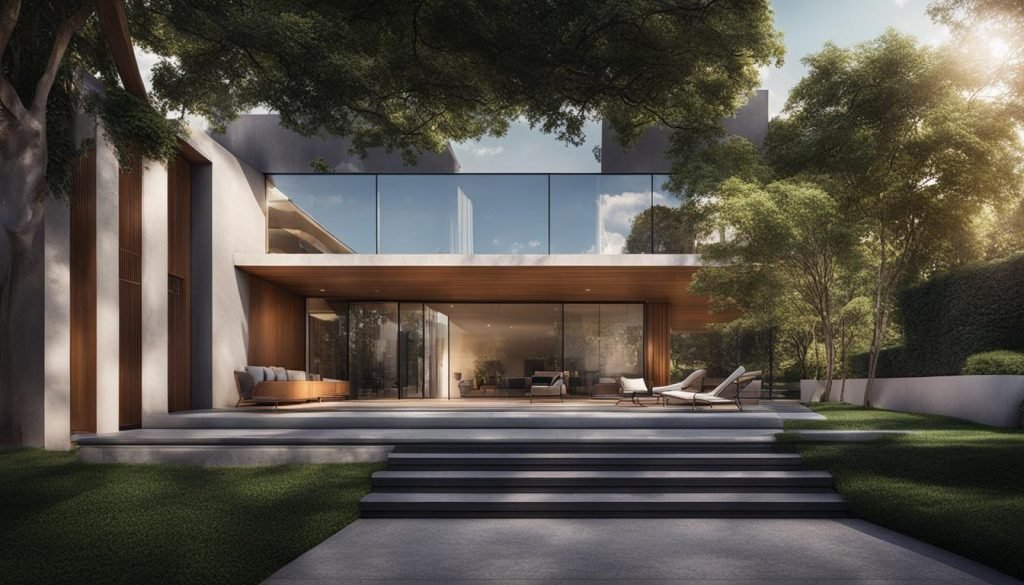
Key Tips:
- Pay attention to details to capture the essence of the architectural subjects.
- Maintain a natural look by avoiding excessive manipulation.
- Use layer masks for non-destructive editing.
- Experiment with different editing styles to create unique visuals.
- Study the works of renowned architectural photographers for inspiration.
“Architectural photography editing is an art that requires both technical skills and creativity. By paying attention to details, maintaining a natural look, and experimenting with different styles, you can create stunning images that capture the beauty and uniqueness of architectural subjects.”
Common Challenges in Architectural Photography Editing
While architectural photography editing can produce stunning results, it also comes with its own set of challenges. These challenges can test the skills and creativity of photographers striving to capture the true essence and beauty of architectural subjects. Understanding and overcoming these challenges is crucial for successful architectural photography editing.
One of the main challenges in architectural photography editing is managing complex lighting situations. Architectural images often involve a mix of natural and artificial lighting, which can create shadows, highlights, and color casts. Balancing these elements while maintaining a realistic representation can be a delicate process.
Perspective distortion is another common challenge in architectural photography editing. Wide-angle lenses used to capture architectural subjects can introduce distortions, such as converging vertical lines. Correcting these distortions while preserving the integrity of the architecture requires careful attention to detail.
Removing unwanted reflections or elements poses yet another challenge in architectural photography editing. This may include removing reflections of the photographer or other unwanted objects that can distract from the main subject. Achieving a clean and clutter-free composition requires meticulous editing techniques.

Maintaining a consistent color balance across multiple images is also a challenge that photographers face in architectural photography editing. When photographing a series of architectural subjects, it is important to ensure that the colors are cohesive and harmonious. This can be particularly challenging when the lighting conditions vary between different shots.
Preserving the architectural integrity of the subjects is another critical challenge in architectural photography editing. While editing can enhance the visual appeal of images, it is important to avoid excessive manipulation that distorts the original architecture. Striking a balance between artistic enhancement and maintaining the authenticity of the subjects is a skill that photographers must master.
Editing Ethics in Architectural Photography
When it comes to architectural photography editing, ethical considerations play a significant role. Maintaining the authenticity of the architectural subjects and representing them truthfully is of utmost importance. Excessive editing or manipulation can misrepresent the architectural subjects and compromise the integrity of the images.
As an architectural photographer, it is essential to strike a balance between enhancing the visual appeal of the images and preserving their truthful representation. Transparency is key. It is crucial to be honest about the editing process and disclose any major manipulations. This ensures that viewers can trust the authenticity of the architectural subjects and the integrity of the images.
“Editing ethics in architectural photography require photographers to be mindful of not misrepresenting the architectural subjects through excessive editing or manipulation.”
Strategies for Ethical Editing:
- Focus on enhancing the natural beauty of the architectural subjects without distorting their true representation.
- Pay attention to details and ensure that any edits made align with the original intent of the architectural design.
- Use selective editing techniques to make targeted adjustments while leaving the overall integrity of the image intact.
- Employ layer masks for non-destructive editing, allowing for greater control and flexibility in the editing process.
- Experiment with different editing styles to find a balance between enhancing the image’s visual appeal and maintaining its authenticity.
By adhering to ethical editing practices, photographers can ensure that their architectural images are not only visually stunning but also preserve the truth and integrity of the architectural subjects. The trust and credibility gained from ethical editing can greatly enhance the value and impact of architectural photography.
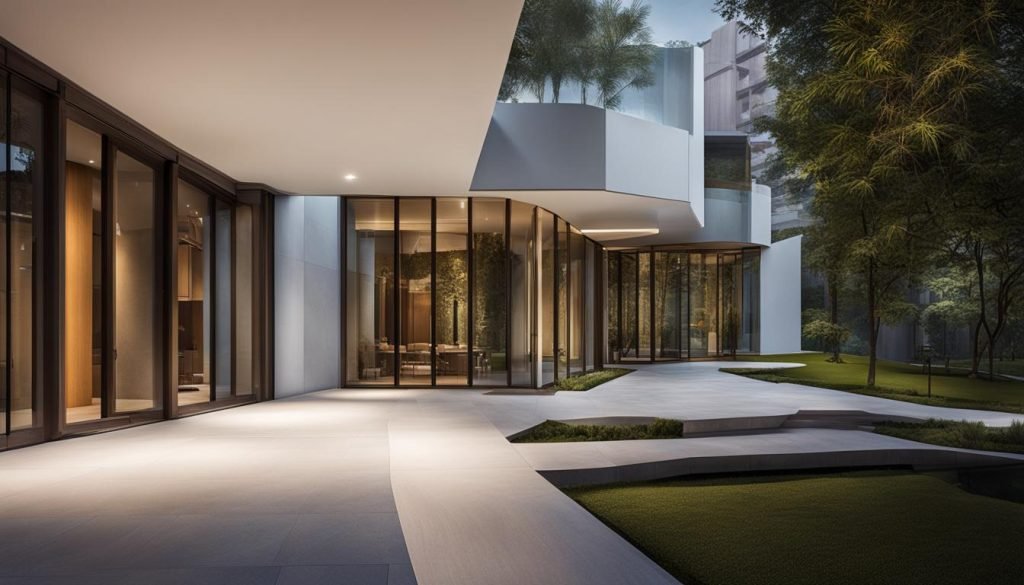
Importance of High-Quality Architectural Photography Editing
High-quality architectural photography editing plays a crucial role in enhancing the visual impact and value of architectural images. Through skillful editing techniques and attention to detail, photographers can elevate their work and captivate viewers with stunning visuals. The process of architectural image enhancement allows photographers to highlight the unique features and aesthetic qualities of architectural subjects, creating a lasting impression.
Professional editing services can help photographers achieve unparalleled results by utilizing advanced tools and techniques. From correcting exposure and white balance to enhancing colors and contrast, editing plays a vital role in bringing out the best in architectural photographs. With the right editing software, photographers can precisely manipulate various elements of their images, ensuring optimal visual appeal.
Investing in high-quality architectural photography editing is particularly important for promotional materials, architectural portfolios, and online publications. Well-executed editing not only showcases the beauty and uniqueness of architectural subjects but also enhances their appeal to potential clients and viewers. By creating visually stunning images, photographers can establish their expertise and attract attention in the competitive architectural photography market.
In conclusion, high-quality architectural photography editing is essential for photographers who want to take their work to the next level. Through meticulous editing techniques, photographers can enhance the visual appeal and value of their architectural images. Whether utilizing professional editing services or honing their own editing skills, photographers should strive for excellence in order to stand out in the industry, attract clients, and create captivating images that leave a lasting impact.
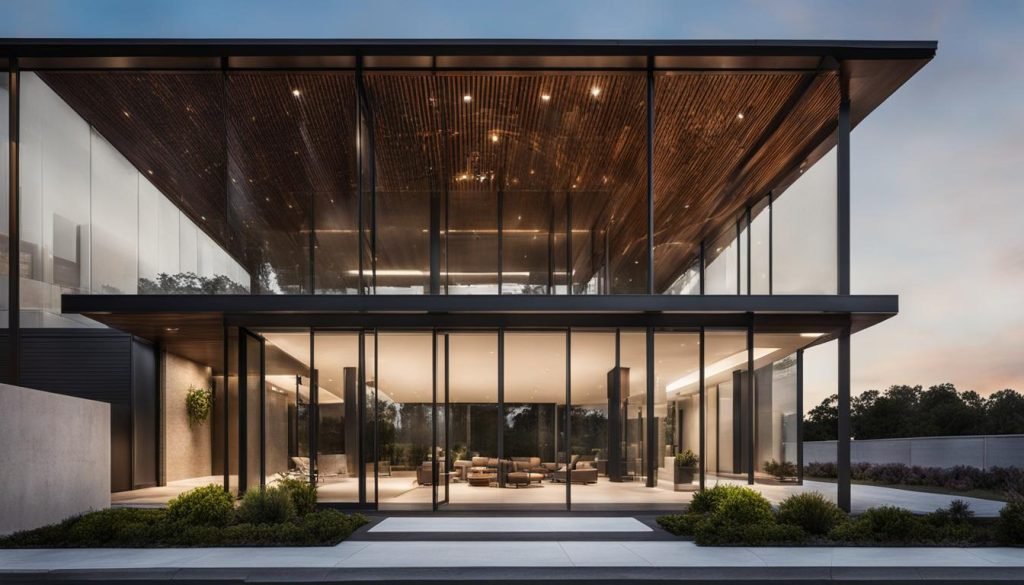
Conclusion
Mastering the art of architectural photography editing is essential for capturing the attention of viewers and showcasing the beauty of architectural subjects. By understanding the goals of editing and utilizing the right techniques, you can elevate your images to new heights. Whether you choose to invest in professional editing services or develop your own expertise, strive for high-quality results that highlight the unique features of your subjects.
Remember, architectural photography editing requires a combination of technical skills, creativity, and attention to detail. Using tools like Adobe Lightroom and Photoshop, along with plugins and presets designed for architectural photography, can enhance your editing process and save you time. Develop a streamlined workflow that includes importing, basic adjustments, specific techniques, fine-tuning, and exporting for consistent and high-quality results.
As you embark on your journey to become a skilled architectural photographer, keep in mind the importance of ethical editing practices. Balance enhancing the visual appeal of your images with maintaining the authenticity and truthfulness of the architectural subjects. Transparency in your editing process and disclosure of major manipulations are key in ethical architectural photography editing.
Whether your architectural images are intended for promotional materials, portfolios, or online publications, investing in high-quality editing is crucial. The right editing techniques can enhance the visual appeal of your subjects, highlight their unique features, and leave a lasting impression on viewers. So take your architectural photography editing skills to the next level and captivate the UK market with stunning and professionally edited images. Start transforming your architectural photographs today!
FAQ
What is the goal of architectural photography editing?
The goal of architectural photography editing is to enhance the visual appeal of images while maintaining a realistic representation of the architectural subjects.
What are some key editing techniques used in architectural photography?
Key editing techniques in architectural photography include adjusting exposure and white balance, enhancing colors and contrast, removing distractions, straightening vertical lines, and correcting lens distortion.
What tools are commonly used for architectural photography editing?
Popular editing software like Adobe Lightroom and Adobe Photoshop, as well as plugins and presets developed specifically for architectural photography, are commonly used tools for architectural photography editing.
What is a typical workflow for architectural photography editing?
A typical workflow for architectural photography editing may include importing and culling images, making basic adjustments, applying specific editing techniques, fine-tuning the images, and exporting them in the desired format.
What are some tips for achieving outstanding results in architectural photography editing?
Tips for achieving outstanding results in architectural photography editing include paying attention to details, maintaining a natural look, utilizing selective editing techniques, using layer masks for non-destructive editing, and experimenting with different editing styles.
What are some common challenges in architectural photography editing?
Common challenges in architectural photography editing include managing complex lighting situations, dealing with perspective distortion, removing unwanted reflections or elements, maintaining a consistent color balance across multiple images, and preserving the architectural integrity of the subjects.
What ethical considerations should be kept in mind during architectural photography editing?
Ethical considerations in architectural photography editing include maintaining the authenticity of the architectural subjects and not misrepresenting them through excessive editing or manipulation. Transparency about the editing process and disclosing major manipulations is also important.
Why is high-quality architectural photography editing important?
High-quality architectural photography editing can greatly impact the perception and value of architectural images. Well-executed editing techniques enhance the visual appeal of the subjects, highlight their unique features, and create a lasting impression on viewers.




